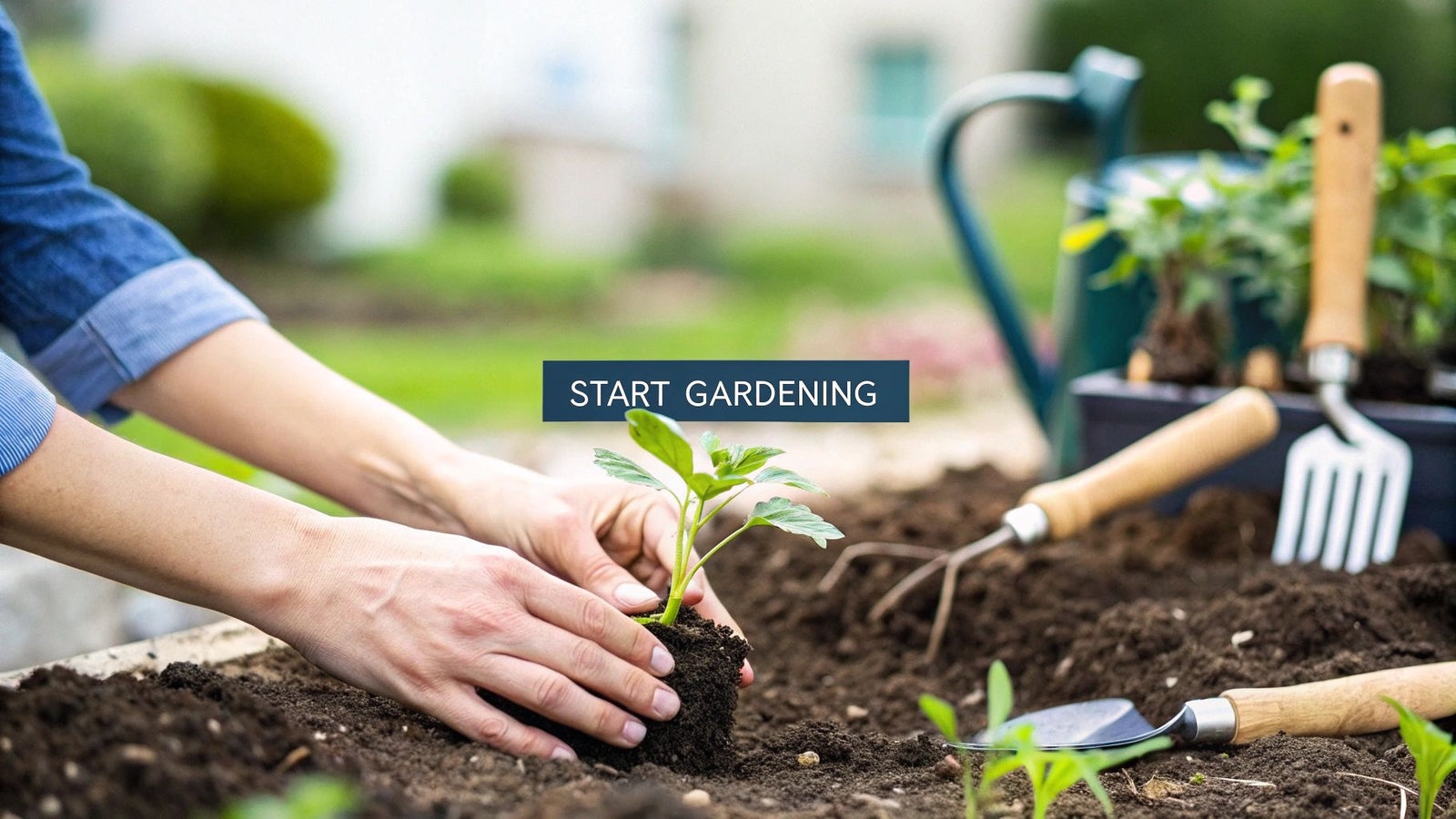
There's nothing quite like the feeling of stepping into your own backyard to pick fresh herbs for dinner or watch a flower you planted finally bloom. If you're new to gardening, the whole idea might seem intimidating, but it really just comes down to a few simple things: giving your plants enough sun, making sure they have good soil to live in, and picking varieties that are easy to grow. Get those right, and you’ll be well on your way to a thriving garden in your very first season.
From First Seed to First Harvest
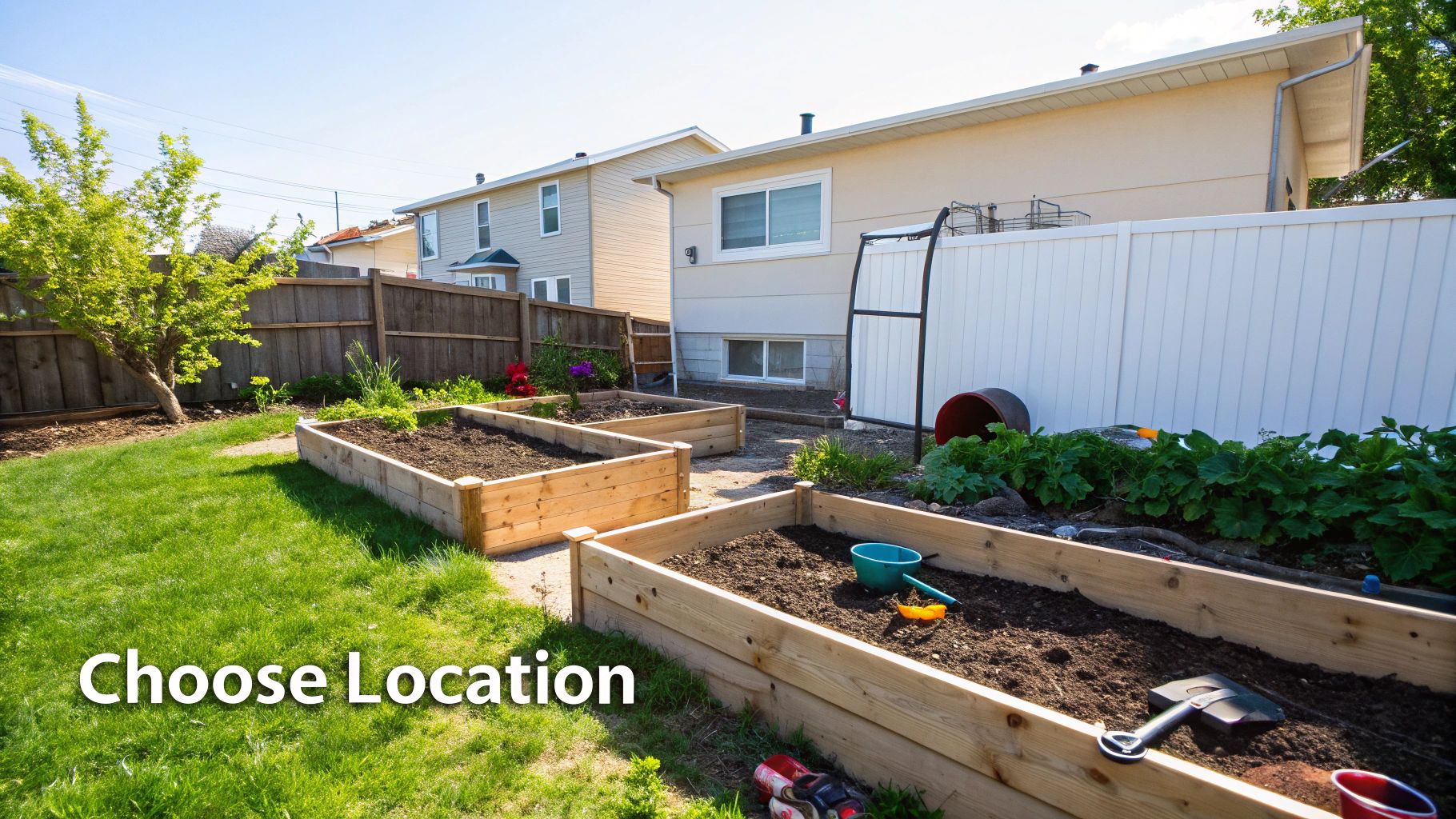
Starting a garden can feel like a massive undertaking, but I promise you, it's one of the most rewarding things you can do. There's a special kind of magic in watching a tiny seed sprout and grow into something you can eat or admire. This guide is here to cut through the confusion and give you clear, honest advice to make the whole process feel less like a chore and more like an adventure.
Let's get one thing straight: you don't need a "green thumb." That's a myth. Good gardening is a skill you learn, not a talent you're born with. With a little bit of planning and the right information, anyone can create a beautiful garden. Your journey starts with understanding a few key ideas before you even pick up a shovel.
What to Expect on Your Gardening Journey
The path from that first seed to your first harvest is full of small, satisfying wins. You'll get to know your own little patch of earth, figure out what your plants are trying to tell you, and learn to work with the seasons. And hey, don't let the thought of failure scare you off. Every single gardener, from the absolute beginner to the seasoned expert, has lost a plant or two. It’s all part of the process.
The good news? Gardening is more popular and successful than ever. Recent stats show that nearly three-quarters (74.1%) of gardeners reported success with their plants, proving that newcomers are getting fantastic results. Plus, with 38.8% of people wanting to grow more food and flowers, you're in good company. You can discover more insights from these gardening statistics to see what other gardeners are up to.
"The biggest myth in gardening is that you need some kind of magic touch. The truth is, you just need good soil, adequate sunlight, and the right plants for your space. Everything else is just learning as you grow."
This guide will walk you through starting a garden in simple, manageable chunks. We'll cover everything you need to know to get started, including:
- Finding the perfect spot with the right amount of sunlight that's also easy for you to access.
- Choosing the right kind of garden for your yard, whether that's a classic in-ground plot, a tidy raised bed, or even just a few pots on the patio.
- Prepping your soil to give your plants the nutrient-rich foundation they need to flourish.
- Selecting and planting your first seeds or starter plants with confidence.
Finding the Perfect Spot for Your Garden
The success of your very first garden really comes down to one thing: location, location, location. And I'm not just talking about the generic advice to "find a sunny spot." You need to become a bit of a sun detective to truly understand the light in your yard and give your plants a real fighting chance.
Before you even think about building beds or buying soil, take a day to just watch your yard. Seriously. See where the sun hits first thing in the morning, where it's strongest at midday, and where it fades in the late afternoon. Most of what you’ll want to grow—think juicy tomatoes, crisp peppers, and vibrant squash—needs at least six to eight hours of direct sun every single day to be productive.
But hold on. If your sunniest patch is a trek to the farthest corner of your property, you might want to reconsider. A great garden spot has to work for you, too.
Don't Forget About Convenience
Picture this: it’s a hot July afternoon, and you're dragging a heavy watering can all the way across the lawn for the third time this week. That gets old, fast. The best garden location is a smart compromise between what your plants need and what you can realistically manage.
As you're scouting potential spots, keep these practical details in mind:
- Easy Water Access: Is there a hose spigot nearby? A rain barrel you can tap into? The closer you are to water, the less of a chore watering will become. Trust me on this one.
- Shelter from the Elements: A location that's protected from constant, whipping wind can be a lifesaver. Strong winds dry plants out and can even snap tender stems. A fence, a wall of your house, or even a line of shrubs can act as a natural windbreak.
- Make It Easy on Yourself: I always suggest placing your garden near a door you use often, like the one leading to your kitchen. It makes it so much easier to pop out for a minute to pull a few weeds or snip some fresh herbs for dinner.
Your garden should feel like a welcoming part of your home, not some chore waiting for you in a far-off corner. When it's easy to get to, you’ll naturally spend more time in it, which is the real secret to success.
Start Small to Win Big
If there's one piece of advice I can give new gardeners, it's this: don't go too big, too soon. It’s so easy to get over-excited and plan a massive plot, but that can quickly become an overwhelming mess of weeds and work. A small, well-tended garden is far more rewarding than a huge, neglected one.
You don't need a ton of space to get started. A simple 4x4 foot raised bed gives you 16 square feet of prime growing real estate—more than enough for a couple of tomato plants, a patch of lettuce, and a handful of your favorite herbs. Even a few large pots on a sunny patio can yield an impressive harvest.
Starting small lets you focus your energy and resources on creating fantastic soil in one contained area. You'll build confidence, learn what works, and enjoy the process. Once you’ve nailed down the perfect spot, you can even get a jump on the season by checking out our guide on when to start seeds indoors.
Choosing Your Garden's Purpose and Style
Before you even think about grabbing a shovel, let's pause and do a little daydreaming. What does your ideal garden look like? Answering this honestly is the single most important thing you can do at the start, because it makes sure the garden you build is the garden you actually want.
Are you imagining a classic kitchen garden, overflowing with salad greens and sweet cherry tomatoes for summer meals? Maybe you're picturing a riot of color, with flowers that bring in a buzz of happy bees and butterflies. Or hey, maybe all you want is a simple pot of fresh basil on your patio.
There’s no wrong answer here. But getting clear on your "why" will make every other decision—from where you put it to what you plant—so much easier.
Deciding on Your Garden's Main Goal
So, what's going to make you happy? A garden should be a source of joy, not a chore, and that starts with aligning it to your lifestyle.
If you're a passionate cook, a vegetable or herb garden is a no-brainer. If you love having fresh-cut flowers in the house, a cutting garden filled with easy bloomers like zinnias and cosmos is the way to go.
Still not sure? Here are a few popular garden themes to get your mind going:
- The Kitchen Garden: This one is all about function and flavor. It’s planted with edibles—vegetables, fruits, and herbs—that you can harvest and bring straight to your table.
- The Pollinator Garden: A beautiful and ecological choice, planted with specific flowers that attract and support vital pollinators like bees, butterflies, and hummingbirds.
- The Container Garden: Perfect if you're working with a small space like a balcony, patio, or even just a sunny stoop. You can grow almost anything in pots, from herbs to small tomato plants.
- The Flower Garden: Designed purely for visual appeal, this garden focuses on creating beautiful combinations of color, texture, and fragrance throughout the seasons.
Choosing a Garden Style That Fits Your Space
Once you have an idea of what you want to grow, the next question is how. The reality of your space, budget, and even your physical comfort will steer this decision. The three most common setups for beginners are traditional in-ground beds, raised beds, and containers. Each has its own set of pros and cons.
My two cents: I started with an in-ground garden and really struggled with our native clay soil. Switching to raised beds was a total game-changer. It let me create the perfect soil mix from scratch, which meant healthier plants and a much bigger harvest.
To help you decide, let's break down the most common options.
Comparing Garden Types for Beginners
Choosing how to structure your garden is a big decision. This table compares the most common methods to help you find the best fit for your home, budget, and needs.
| Garden Type | Best For | Pros | Cons |
|---|---|---|---|
| In-Ground Bed | Gardeners on a budget with decent existing soil and a larger yard. | Most affordable option; allows for large, flexible layouts. | Requires working with your native soil, which may need lots of amending (digging!). |
| Raised Bed | Beginners, gardeners with poor soil (clay/sand), or those who want less bending. | Excellent drainage; soil warms faster in spring; easier on the back; total control over soil quality. | Higher initial cost for materials (wood, soil); can dry out faster than in-ground beds. |
| Container | Renters, small spaces (balconies/patios), or anyone wanting flexibility. | Portable; can be placed anywhere with sun; great for controlling pests and soil. | Requires frequent watering (often daily in summer); limited root space restricts plant size. |
Ultimately, the "best" garden style is the one that you can realistically build and maintain. Don't be afraid to start small!
Picking Your First Plants
Alright, you know your purpose and you've picked a style—now for the really fun part. It’s time to choose your plants! The goal for your first year is simple: success. To get there, you want to pick plants that are known for being easy to grow and productive.
This simple chart shows how a few classic beginner plants compare. It's a great visual for understanding that even "easy" plants have their own preferences.
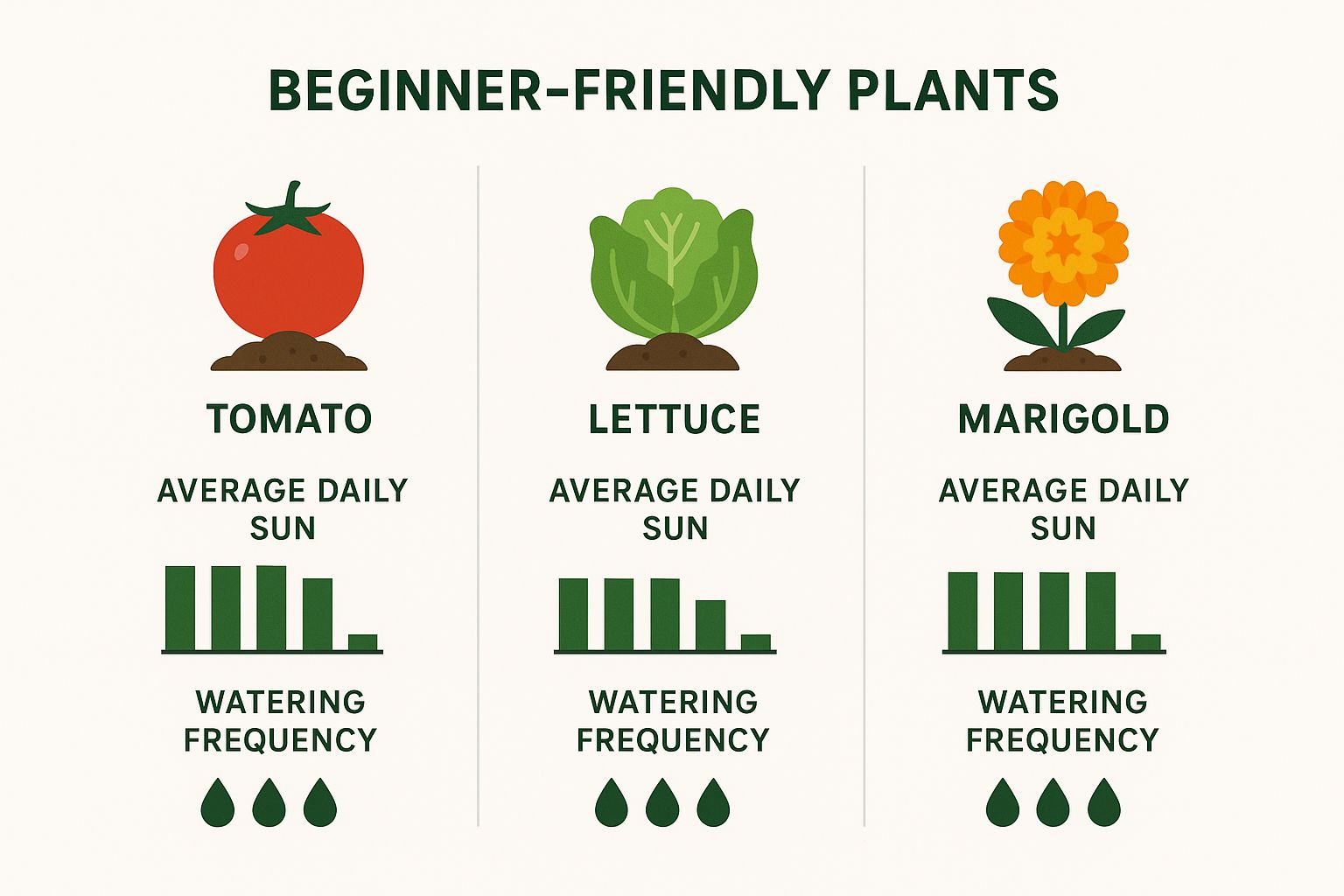
You can see right away how a sun-loving, thirsty plant like a tomato has very different needs from lettuce, which is much less demanding. Keeping these basic requirements in mind when you're at the garden center will set you up for a fantastic first season.
Creating Healthy Soil for Thriving Plants
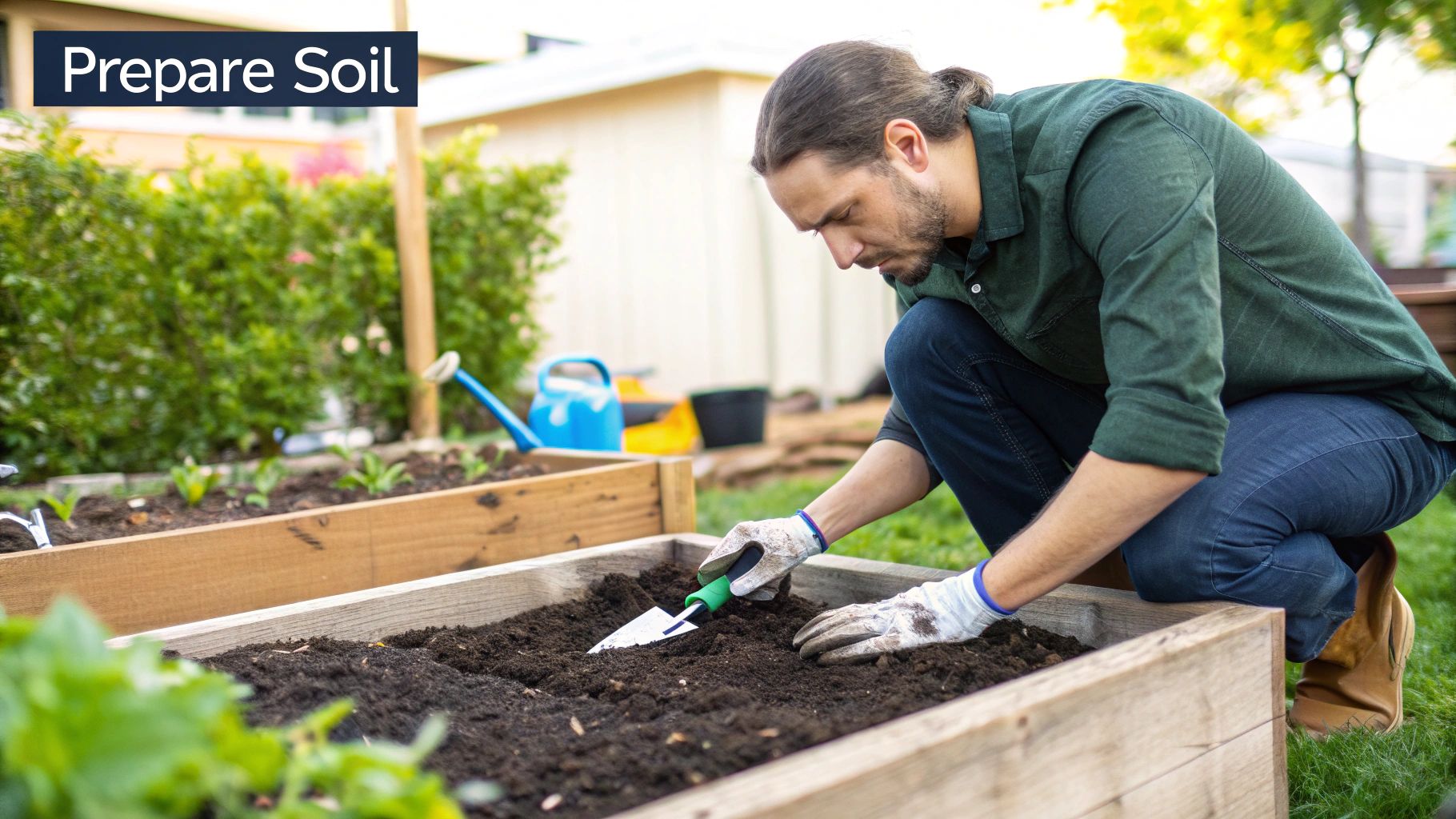
If your garden plot is the real estate, then your soil is the foundation. It’s that simple. In my experience, nothing impacts your garden’s success more than the quality of the soil you start with. It’s what provides the food, water, and air your plants need to grow strong.
Think of it this way: your plants can only be as healthy as what they're living in. Thankfully, you don't need a degree in soil science to get it right. For a new gardener, the goal is to create soil that looks dark, feels crumbly, and is full of life.
Whether you're digging up a patch of lawn or filling brand-new raised beds, building this foundation is your next crucial step. It’s an investment of time and effort that will pay you back all season long with healthier plants and fewer headaches.
Get to Know Your Native Soil
First things first, go get your hands dirty. Seriously. Grab a handful of soil from your garden spot and give it a squeeze. This simple "feel test" can tell you a surprising amount about what you’re working with.
- Heavy Clay Soil: Does the soil form a tight, slick ball that doesn't fall apart? You've likely got clay. Clay is nutrient-dense, but it gets rock-hard and compacted, making it tough for roots to penetrate and for water to drain away.
- Sandy Soil: Does it feel gritty and just fall through your fingers, refusing to hold a shape? That's sandy soil. Sand drains incredibly fast—sometimes too fast, meaning water and nutrients wash away before your plants can grab them.
- Loamy Soil: Does it hold together when squeezed but then crumble apart beautifully when you poke it? Congratulations! That's loam, the gold standard for gardeners. It holds moisture and nutrients perfectly without getting waterlogged.
Most of us aren’t lucky enough to start with perfect loam, and that’s completely fine. Whatever your soil type, the solution is almost always the same: add organic matter.
The secret to fixing almost any soil problem—from sticky clay to bone-dry sand—is compost. It works wonders by acting like a sponge. It helps sandy soil hold onto water and breaks up dense clay particles to improve airflow and drainage.
The Magic of Compost and Organic Matter
Organic matter is the lifeblood of fertile soil. It's just decomposed material from things that were once alive, like leaves and plants. The easiest and most effective form for any gardener to use is compost.
Compost is that dark, crumbly, sweet-smelling stuff that’s packed with beneficial microbes. When you mix it into your garden, it works magic—improving soil structure, helping retain moisture, and slowly feeding your plants over the entire season. For a brand new in-ground garden bed, a great rule of thumb is to spread 2 to 4 inches of quality compost over the top and work it into the top 6 to 8 inches of soil.
If you’re filling new raised beds, you get to play soil chef and create the perfect mix from scratch. A tried-and-true recipe is blending equal parts of compost, topsoil (or a bagged garden soil), and something for aeration like perlite or vermiculite. To make this critical step even easier, we have a complete guide on preparing your garden soil for planting that goes into more detail. Getting this mix right from day one sets your plants up for a successful and bountiful season.
Choosing and Planting Your First Crops
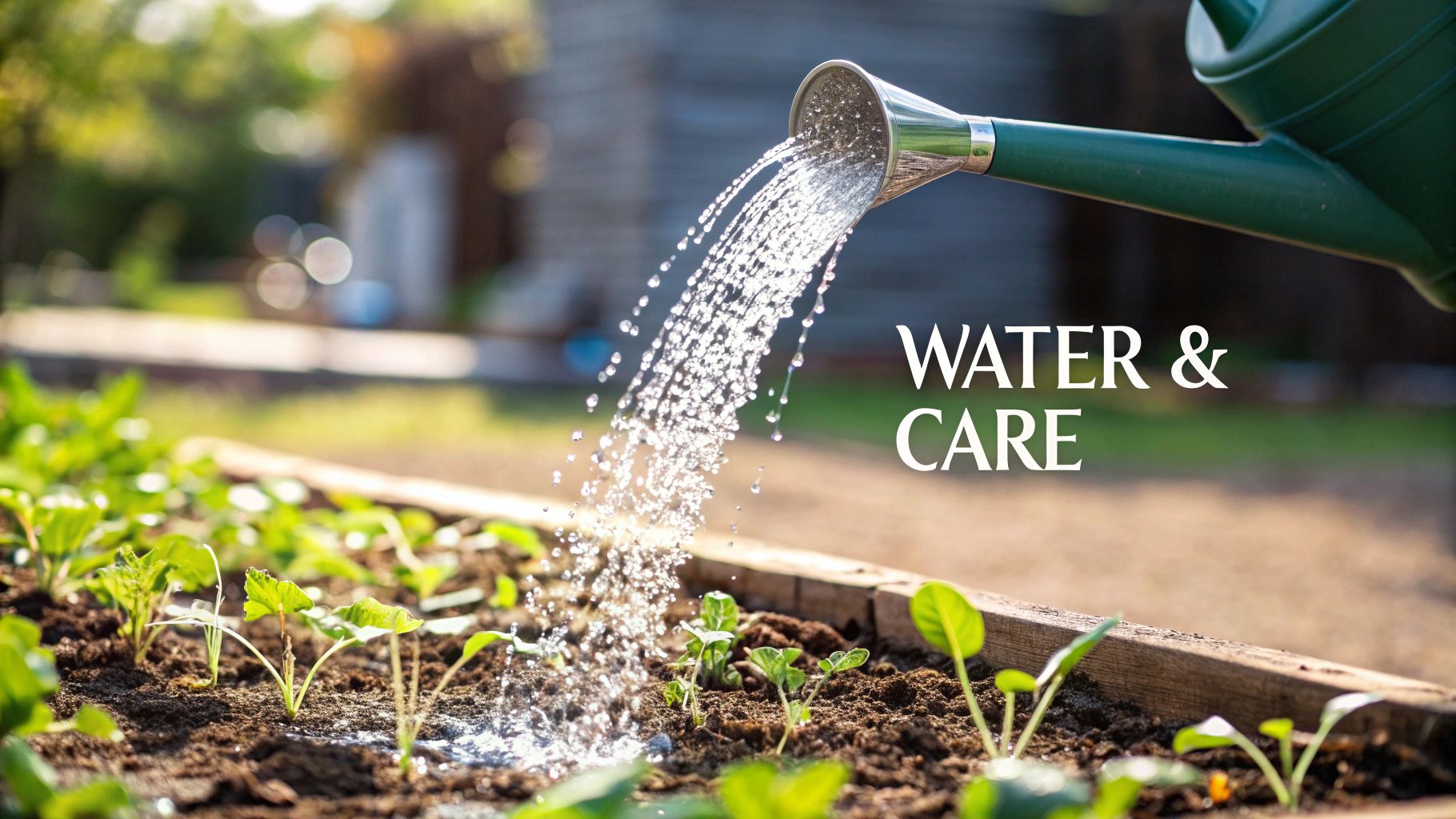
Alright, this is where the real fun begins. Your garden bed is prepped, the soil is looking great, and now it's time to actually plant something. For your first garden, you'll face a fundamental choice: start with seeds, or get a head start with young plants (often called "starts" or "transplants").
Seeds are fantastic because they're inexpensive and the variety is seemingly endless. The trade-off? They require more patience and attention right from the start. On the other hand, buying starts from a nursery gives you a serious jump on the growing season. It's a great option if you're a bit anxious to see results. There's truly no right or wrong answer here; it's all about what you feel ready to tackle.
Deciding Between Seeds and Starts
I often recommend a hybrid approach for first-timers. For plants that take a while to mature, like tomatoes and peppers, buying starts is a smart move. It shaves weeks off their long growing season and gives you a wonderful confidence boost right out of the gate.
For other crops, especially those that grow quickly or hate having their roots messed with, planting seeds directly in the garden is the only way to go. Think of plants like:
- Radishes
- Carrots
- Beans
- Lettuce and other salad greens
Using starts for the long-haul plants and seeds for the quick growers is a balanced strategy. You get to experience both methods without feeling completely overwhelmed.
How to Select the Healthiest Plants
If you go the route of buying starts, learning to spot a healthy plant is a skill that will pay off for years. Don't just grab the biggest one on the shelf.
Look for starts that are compact and bushy with vibrant, deep green leaves. Steer clear of any that look tall and spindly ("leggy"), have yellowing leaves, or are already trying to flower in their tiny containers. These are all signs of stress.
Take a moment to gently slide a plant out of its pot. You want to see healthy, white roots that fill the space but aren't a dense, tangled mat circling the bottom. That's the sign of a plant that’s ready to thrive in your garden.
A Pro Tip: A small, vigorous start will almost always outperform a large, stressed one. The smaller plant will quickly adapt to your garden soil and take off, while the root-bound, oversized one might sit there, stunned, for weeks.
Even as economic winds shift, gardening remains a rewarding hobby. In fact, 70% of new gardeners reported feeling successful last year. Interestingly, many are becoming more budget-conscious, with a 22% drop in seed purchasing to save money. This shows that while starts have a higher initial cost, their reliability is a huge draw for beginners. You can learn more about recent gardener priorities and spending habits to see what's driving these trends.
To set yourself up for a bountiful harvest, stick with plants known for being dependable. We've put together a handy list of the best vegetables to grow for beginners to help you pick some low-fuss, high-reward winners.
Bringing Your Garden to Life: Essential Care Routines
With your seeds and seedlings nestled in their new home, the real fun begins. This is where the magic happens—transforming that patch of prepared soil into a lush, productive garden. The secret isn't back-breaking labor; it's about creating a simple, steady rhythm of care that helps your plants thrive.
Watering is, without a doubt, the most critical task. Young plants are thirsty as they work hard to establish their roots. But here’s a tip I learned the hard way: a quick, light sprinkle every day is often worse than no water at all. It encourages shallow, weak roots that can't handle a sudden heatwave.
The goal is to water deeply and less often. Aim for about one inch of water per week, including any rainfall. Forget guesswork—just use the "finger test." Stick your finger a couple of inches into the soil near your plants. If it feels dry down there, it's time to water. And when you do, give the soil a good, long soak right at the base of the plants. Early morning is the best time, as it minimizes evaporation and helps prevent fungal issues that can pop up when leaves stay wet overnight.
Tackling Weeds and Pests Like a Pro
Ah, weeds. They're a fact of life for any gardener, but they don't have to be a nightmare. The trick is to get them while they're small. Seriously, spending just 5-10 minutes pulling up tiny sprouts a few times a week is so much easier than wrestling with deep-rooted monsters later.
Your best friend in the war on weeds? Mulch. A simple 2-3 inch layer of straw, shredded leaves, or wood chips spread around your plants is a game-changer. It accomplishes three things at once:
- Smothers Weeds: It blocks sunlight, so most weed seeds never even get a chance to sprout.
- Saves Water: It acts like a protective blanket, dramatically slowing down evaporation from the soil. You'll find you need to water less often.
- Controls Temperature: It helps keep the soil cool during hot summer days and warmer when the nights turn chilly.
Of course, weeds aren't the only uninvited guests. To keep your harvest for yourself, it's worth looking into Smarter Garden Pest Control. For beginners, many issues can be solved with simple, hands-on methods. I often just hand-pick larger pests like hornworms off my tomatoes or use a strong jet of water from the hose to blast aphids off my kale.
Feeding Your Plants for a Bountiful Harvest
Remember that rich compost you mixed into the soil? Think of that as the main course for your plants. But some crops, especially heavy feeders like tomatoes, peppers, and squash, get extra hungry during the peak of the growing season. They can use a little boost, just like a runner needs extra fuel during a marathon.
This is where "side-dressing" comes in. It sounds fancy, but it's not. About a month after planting, you can just sprinkle a bit of granular organic fertilizer in a circle around the base of your plants or give them a drink of a liquid feed like fish emulsion. Just be sure to follow the instructions on the package; it's possible to be too generous, and over-fertilizing can burn your plants' roots.
Gardener's Insight: A healthy plant is a strong plant. Proper watering and feeding are your best defense, making your garden naturally more resilient to pests and diseases before they even start.
It's clear people are rediscovering the joy of growing their own food. The global home gardening market was valued at $15.78 billion and is expected to climb to $26.47 billion by 2034. It's a boom fueled by a desire to connect with nature and by great new tools that make gardening easier than ever. You can discover more insights about the home gardening market and see what's driving this exciting trend.
By building these simple routines, you’re not just maintaining a garden—you’re cultivating a rewarding and delicious new hobby.
At Homegrown Garden, we're passionate about helping you grow. From heirloom seeds to complete starter kits and expert guides, we provide everything you need to cultivate a thriving garden. Explore our collection at https://www.homegrown-garden.com and start your journey today.



